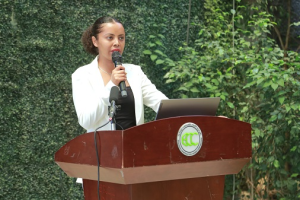Forced to flee their home, school, and all things familiar – this is the reality of a young refugee or displaced person. Once in a new place, they sometimes have access to an in-camp school or some informal opportunities. Less common is full integration into the national school system.
While the latter is one of the most promising ways to integrate into a new country, education officials often report that they face a myriad of challenges in providing education for refugees in national systems. Ethiopia is a prime example of a country taking serious steps towards the integration of refugees and displaced persons into national systems, including education. This is within the context of a long history of welcoming refugees.
Today, over 900,000 persons from some 24 countries – predominately Eritrea, Somalia, and South Sudan – call Ethiopia home, according to UNESCO. In November 2017, Ethiopia became one of the first countries to roll out the Comprehensive Refugee Response Framework. This aims to enhance refugee self-reliance and inclusion in national development plans, provide refugees with better possibilities to improve their lives, and ease pressure on host countries as a way to promote peaceful co-existence. Access to quality education is a central part of the country’s efforts to improve the plight of refugees.
It is also a shared responsibility, requiring the involvement and expertise of a multitude of actors including the Ministry of Education, and humanitarian and development partners. ‘We have to be involved as a nation,’ explained Getachew Admasu Bishaw, Project Monitoring & Evaluation Senior Expert, Ministry of Education, at a recent IIEP workshop held in Nairobi, Kenya, in March 2018, in partnership with UNESCO, UNHCR, UNICEF, and the Global Education Cluster.
‘It is in line with the Sustainable Development Goals, and our Ministry – our country – signed this pledge.’ Ashenafi Demeke Kebede, Senior Education Officer, Administration for Refugee and Returnee Affairs (ARRA), also told IIEP that the inclusion of school-aged refugees in the national education plan has many benefits for all learners. In addition to being cost-effective, he noted, ‘if there is a comprehensive plan to include refugees it engages everybody so that also develops social cohesion and harmonization. It provides a sustainable solution.
If refugees are included in the long-term plan there is then a good bridge and we can sustain the humanitarian support and have a development impact in the long term.’ However, a number of different entities working in education can also result in what Kebede calls ‘parallel planning’, or planning for different segments of the population separately, without close coordination. This is common not only in Ethiopia, but in many countries with large refugee populations.
As a result, education for refugees may not be prioritized. Even more likely is that refugees remain outside the formal school system. The United Nations Refugee Agency (UNHCR) highlights in their 2017 report working towards Working Towards Inclusion: Refugees Within the National Systems of Ethiopia that while refugee children and youth have the right to access national schools, 48 per cent remain outside of the formal school system in Ethiopia. Joint education sector planning is a way forward, as is improved coordination among all partners on educational planning and management.
This can help ensure the successful implementation of refugee education services, as well as lay the foundation to ensure equity in the provision of education in refugee camps and host communities. In the just ended 2018, a project to construct schools in refugee camps and host communities in Gambella and Benishangul-Gumuz regions in Ethiopia has been launched.
Part of a US$15 million two-year investment in refugee education in Ethiopia by Education Cannot Wait, the project will construct three new inclusive model secondary schools, 41 classrooms in eight secondary schools, and 84 classrooms in four primary schools. About 12,000 children from refugee camps and the surrounding host communities – half of them girls – are expected to benefit. The project will result in 3,600 children being enrolled in secondary school and 8,400 in primary school.
The schools are expected to be ready in time for the 2019-2020 academic year. Each new school will be fully equipped with furniture, laboratories, libraries, teachers’ offices, and gendersegregated latrines. “Ethiopia has a history of generosity in hosting refugees. The international community must play its part and support Ethiopia’s efforts for children and youth uprooted by conflict and violence to fulfill their right to quality education and ensure they can learn and thrive,” says Yasmine Sherif, Director of Education Cannot Wait.
The project will boost gross enrollment numbers in both regions. Currently, secondary school gross enrollment in host communities in Benishangul-Gumuz is 33 per cent and 66 per cent in the Gambella Region. The numbers are significantly lower among refugees at 8 per cent and 13 per cent in Benishangul-Gumuz and Gambella respectively.
In addition to school construction, Education Cannot Wait is improving the quality of education by providing school improvement grants, teaching and learning materials plus improving the capacity of teachers to deliver quality and inclusive education. These efforts are benefitting both host and refugee communities thereby enhancing the gradual integration of refugee education services into the national education system.
Herald January 3/2011
COMPILED BY GIRMACHEW GASHAW





